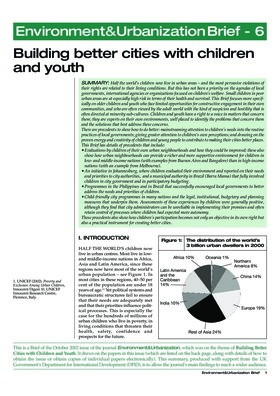Building better cities with children and youth

Half the world’s children now live in urban areas - and the most pervasive violations of their rights are related to their living conditions. Children and youth have a right to a voice in matters that concern them. They are also experts on their own environments, well placed to identify the problems that concern them and the solutions that best address these concerns.
There are precedents to show how to do better: mainstreaming attention to children’s needs into the routine practices of local governments; giving greater attention to children’s own perceptions; and drawing on the proven energy and creativity of children and young people to contribute to making their cities better places. This Brief has details of precedents that include:
* Evaluations by children of their own urban neighbourhoods and how they could be improved; these also show how urban neighbourhoods can provide a richer and more supportive environment for children in low- and middle-income nations (with examples from Buenos Aires and Bangalore) than in high-income nations (with an example from Melbourne).~* An initiative in Johannesburg, where children evaluated their environment and reported on their needs and priorities to city authorities, and a municipal authority in Brazil (Barra Mansa) that fully involved children in city government and in participatory budgeting.~* Programmes in the Philippines and in Brazil that successfully encouraged local governments to better address the needs and priorities of children.~* Child-friendly city programmes in many nations and the legal, institutional, budgetary and planning measures that underpinned them. Assessments of these experiences by children were generally positive, although they find that city administrators can be unreliable in implementing their promises and adults often retain control of processes where children had expected more autonomy.
Cite this publication
Available at https://www.iied.org/10514iied